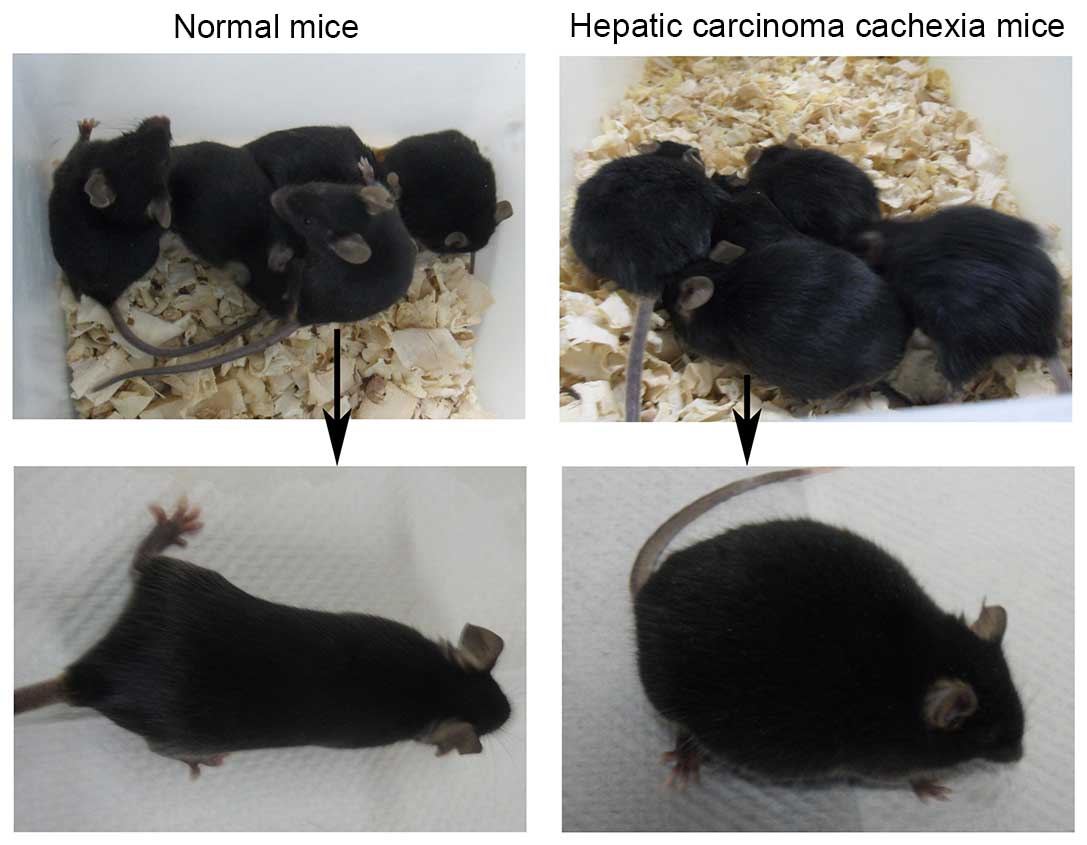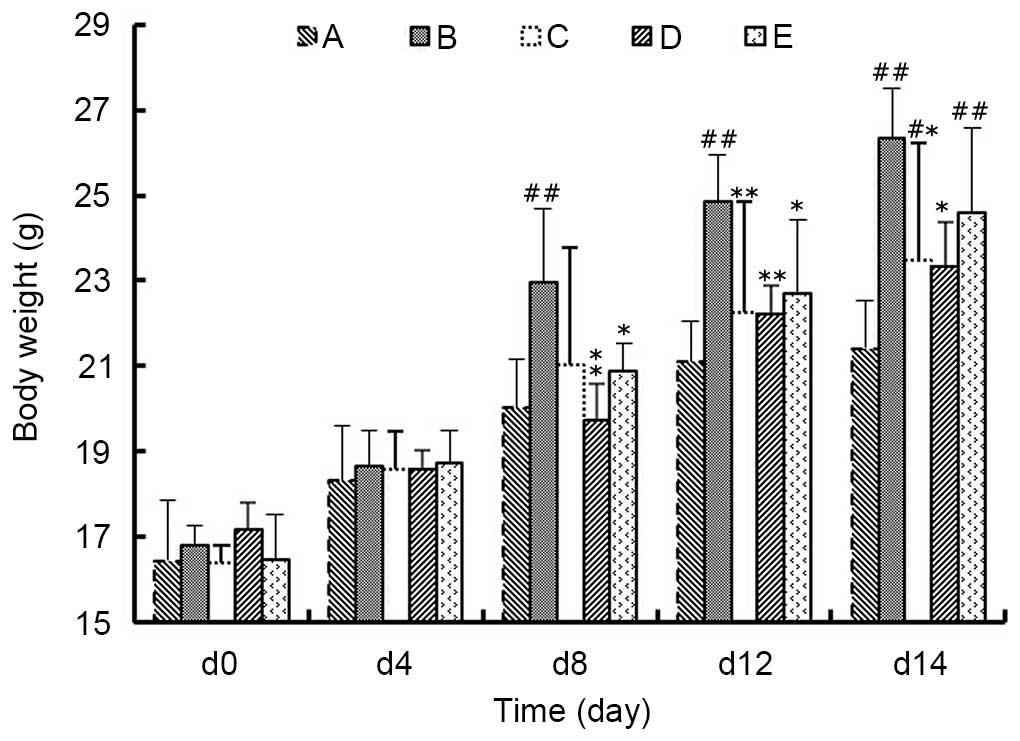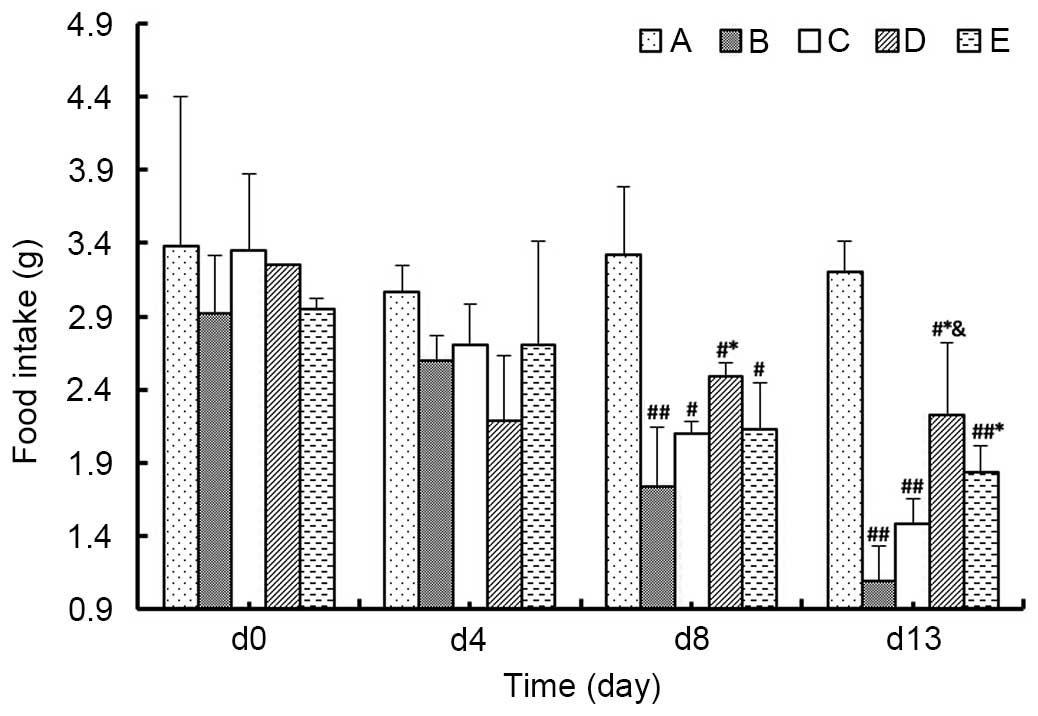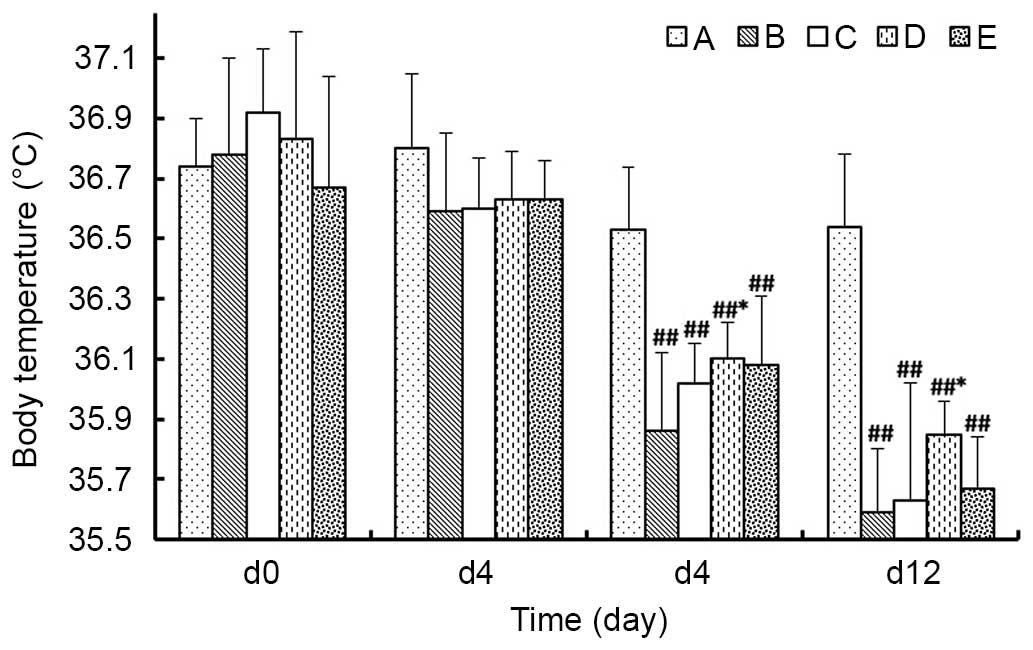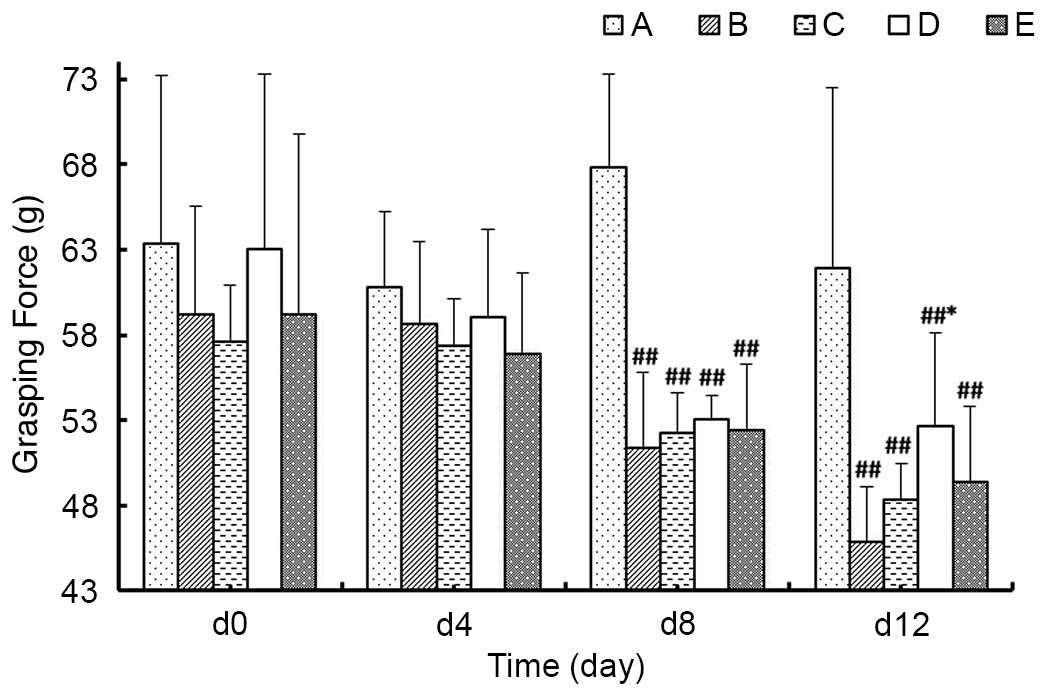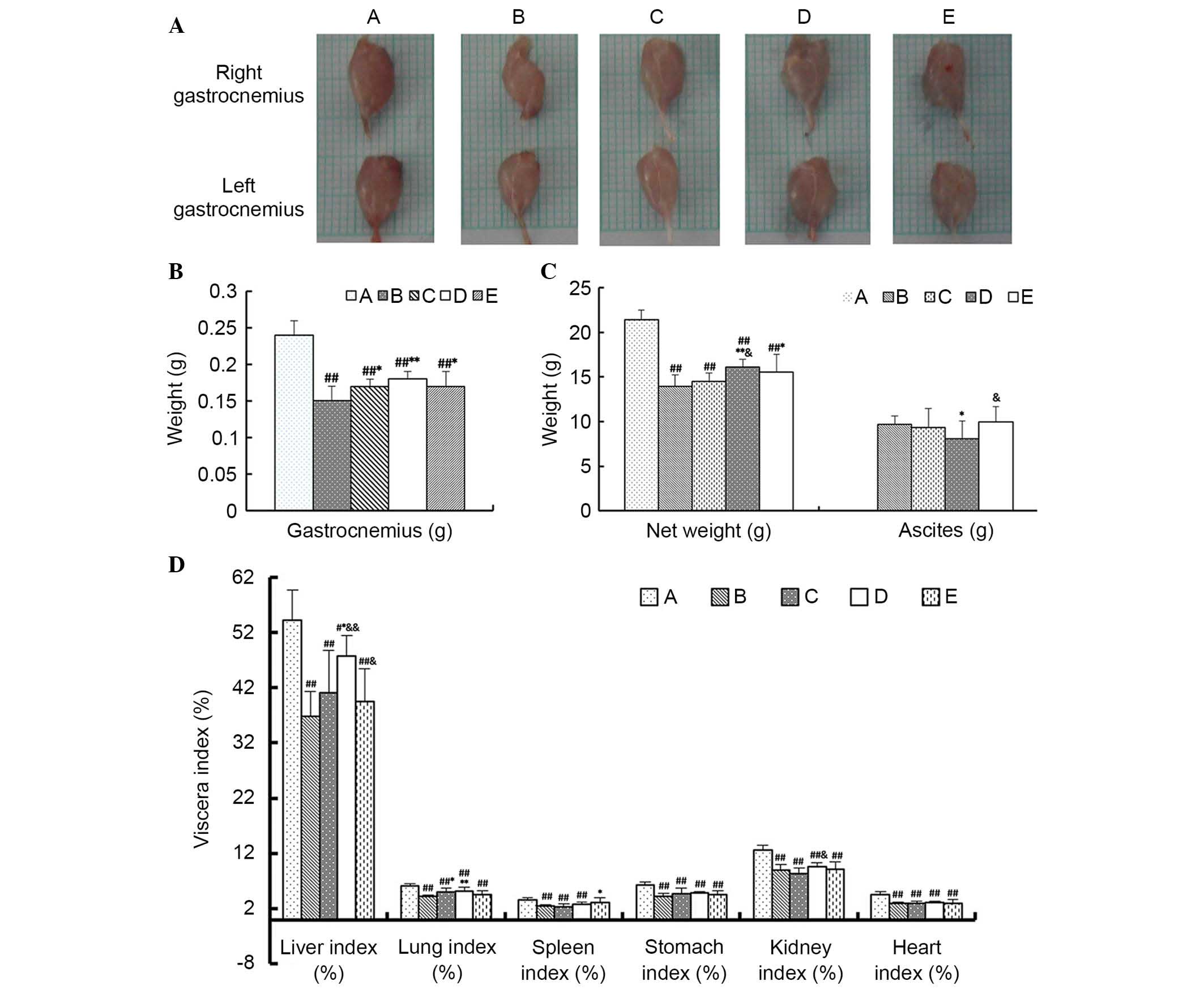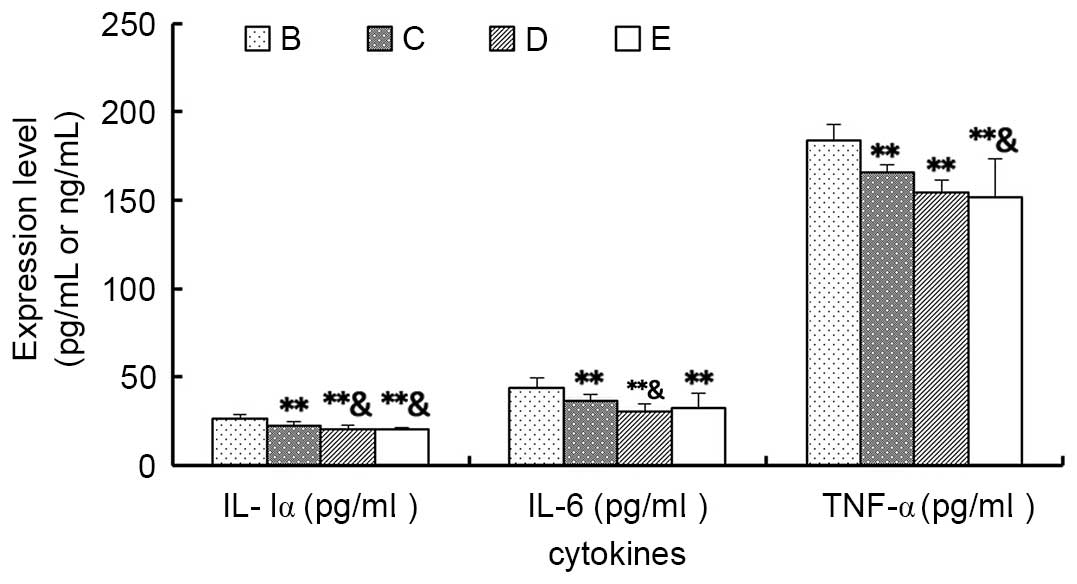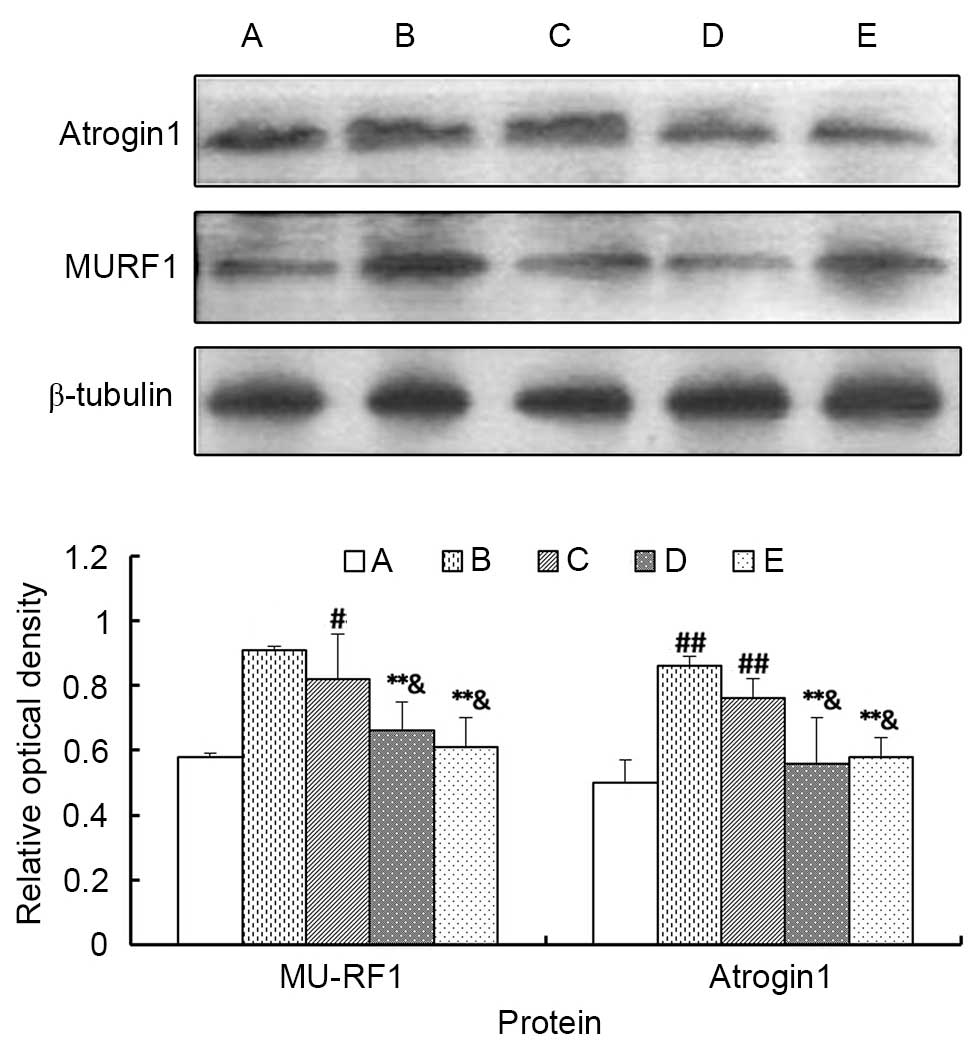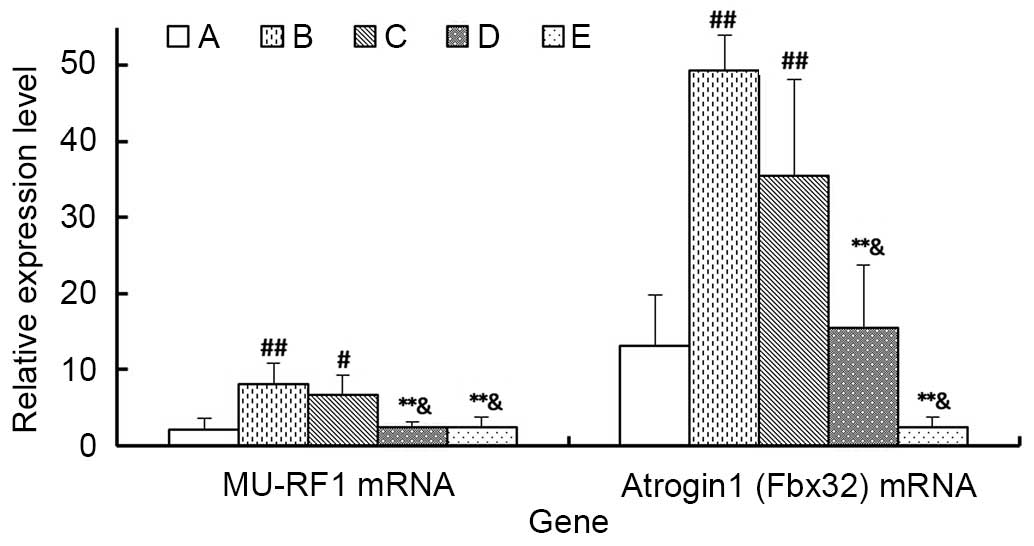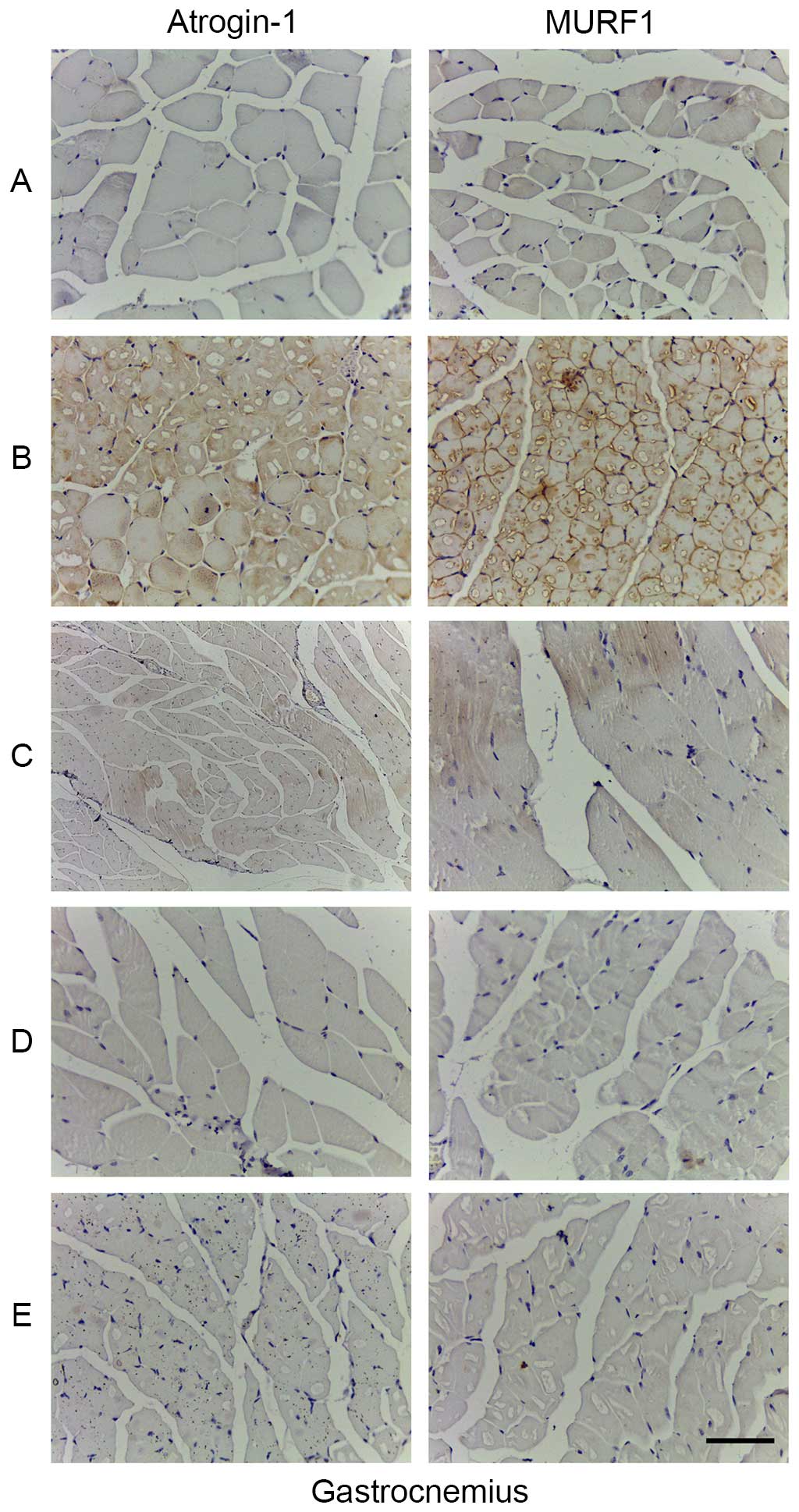The study on mechanism of the modified Chinese herbal compound, jianpijiedu, on a mouse model of hepatic carcinoma cachexia
- Authors:
- Published online on: August 8, 2016 https://doi.org/10.3892/mmr.2016.5602
- Pages: 3113-3121
-
Copyright: © Sun et al. This is an open access article distributed under the terms of Creative Commons Attribution License.
Abstract
Introduction
Cancer cachexia (CC) is a clinical syndrome characterized by progressive loss of the skeletal muscle with or without fat loss, which cannot be reversed by traditional nutritional support therapy, leading to progressive body (1). Specifically, CC may give rise to anorexia, anemia, acceleration of proteolysis and even dysfunction of the organs, which leads to the progressive loss of skeletal muscle (2). It has been previously reported that CC may affect >80% of patients with cancer, which directly affects the overall survival and the life quality of the patients, reduces the tolerance to radiotherapy and chemotherapy, and increases the occurrence rate of complications, thus CC is regarded as an crucial cause of death in patients with cancer (3,4). The pathogenesis of CC remains complex, and there is little information regarding the use of therapeutic strategies including anti-inflammatories, appetite stimulation and nutritional support, which may aid in the prevention of skeletal muscle degeneration, however further investigation is required (5,6).
As a therapy for liver cancer, the modified Chinese herbal compound jianpijiedu (MCHCJ; patent no. 2009100420702) may significantly enhance survival in a hepatic carcinoma mouse model, postpone the development of tumors and maintain the body weight of the xenografted mice (7,8). However, the mechanism of the effect remains unclear, thus, based on previous research and the characteristics of the ascites-induced hepatic carcinoma cachexia, the current study used MJPJD and the Traditional Chinese Medicine principal of warming Yang for diuresis and promoting Qi for purging fu-organs, in a mouse model of hepatic carcinoma to investigate the effects and the mechanism of MJPJD on hepatic carcinoma cachexia.
Materials and methods
Experimental animals and cancer cell lines
A total of 52 male C57BL/6 mice (certification no. 00014376), aged 4–6 weeks and weighing 14–17 g, were provided by the Guangdong Province Experimental Animal Center [approval no. SCXK (Guangdong) 2013-0002]. The H22 ascites-oriented hepatic carcinoma cells were provided by the Experimental Animal Center of Sun Yat-sen University [Approval No. SCXK (Guangdong) 2013-0081]. The H22 cell lines were frozen, then while thawing, the cells were washed by phosphate-buffered saline (PBS; Wuhan Boster Biological Technology, Ltd., Wuhan, China) three times, then were diluted to 106 cells/ml. All the experimental procedures were performed in specific pathogen-free animal laboratory, environmental and facility at 24–26°C, an air pressure of 20–50 Pa and a relative humidity of 40–70% with a 12/12 h light/dark cycle. Mice were fed with a diet comprised of water (≤10%), crude protein (≥18%), crude fat (≥4%), crude fiber (≥5%), crude ash (≤8%), calcium (1.0–1.8%) and phosphorus (0.6–1.2%) according to the National Standard of China (GB 14924.3-2001). All the animal experiments were conducted in strict accordance with the ethical principles that were approved and supervised by the Ethics Committee of the First Affiliated Hospital of Sun Yat-sen University [Approval no. ethical application (2013) no. 149].
Medicines and reagents
MCHCJ (supplied by the Department of Pharmacy of the First Affiliated Hospital of Sun Yat-sen University, Guangzhou, China) composed of 30 g Codonopsis, 15 g poria, 15 g atractylodes, 6 g licorice, 15 g Curcuma, 30 g Scutellaria barbata, 6 g dried tangerine, 15 g Magnolia officinalis, 15 g immature bitter orange, 15 g Coptis chinensis, 15 g Scutellaria baicalensis, 15 g Rhizoma anemarrhenae, 15 g Grifola, 15 g Rhizoma alismatis, 6 g Fructus amomi, 15 g turmeric, 15 g Pinellia ternata and 10 g Semen pharbitidis, were all dissolved in 75°C distilled water to a concentration of 7.5 g/ml. The medroxyprogesterone (MPA) (Zhejiang Xianju Pharmaceutical Co., Ltd., Taizhou, China) was dissolved to 24 g/ml in 25°C distilled water. The indometacin (IND) enteric-coated tablets (Zhongsheng Pharmacy, Guangzhou, China) was dissolved to 0.1 g/ml in 25°C distilled water and well shaken. All the dilutions were stored at 0°C prior to use.
The interleukin-1α (IL-1α; cat. no. MUE027), the IL-6 (cat. no. MUE044) and tumor necrosis factor-α (TNF-α; cat. no. MUE030) enzyme-linked immunosorbent assay (ELISA) kits were purchased from the ShanghaiBangyi Biotechnology Co., Ltd. (Shanghai, China). Rabbit anti-F-box protein 32 (also termed atrogin 1) antibody (cat. no. ab74023) and rabbit anti-muscle RING-finger protein-1 (MU-RF1) antibody (cat, no. ab77577) were purchased from Abcam (Cambridge, MA, USA). Mouse anti-β-tubuin antibody (cat. no. AC008) was purchased from ABclonal Biotech Co., Ltd. (Wobrun, MA, USA). Goat anti-rabbit horseradish peroxidase-conjugated antibody (cat. no. PV-6001) was purchased from OriGene Technologies, Inc. (Beijing, China).
Devices
The infrared thermometer for animals (model DT-8866) was purchased from the Shenzhen Kai Heng Jie Tech Co., Ltd. (Shenzhen, China) and the improved grasping force measuring instrument (patent no 201030634194.3) was purchased from the Guangzhou Weiheng Electronics Co., Ltd. (Guangzhou, China).
Method
Model establishment
Two C57BL/6 mice were selected randomly to be injected with 106 H22 ascitic hepatic carcinoma cells. On day 7 post-injection, the mice were sacrificed by overdose anesthesia; 4 ml ether (Tianjin Damao Chemical Reagent Factory, Tianjin, China) was transferred to a 15-ml centrifuge tube and a cotton ball was added and left to soak. Following soaking, the cotton ball was placed in front of the nose of the animal inducing anesthesia. Subsequent to sterilization, the ascites were extracted then were centrifuged (600 × g, 2 times for 5 min at 4°C), and the supernatant was discarded. The survival rate of tumor cells was >95%, observed by the optical microscopy and trypan blue staining, the ascites were dissolved in saline and diluted to a cell suspension of 107/ml, and 0.2 ml of the suspension was intraperitoneally injected into 40 C57BL/6 mice to establish the model of ascites-induced hepatic carcinoma cachexia.
Grouping and intervention
C57BL/6 mice which received model establishment (n=40) were randomly divided into five groups, as follows: xenograft tumor group (Group B); low concentration of MJPJD administration group (Group C); high concentration of MJPJD administration group (Group D); and MPA combined with IND administration group (Group E). Additionally, 10 mice were used as the control group (Group A), which received injection of an equivalent volume of saline. The intervention was initiated on day 6 of model establishment and administered daily for 8 days. Groups A and B received the intragastric administration of the 0.1 ml/10 kg saline, Groups C and D received the intragastric administration of 37.5 g/kg and 75 g/kg MJPJD, respectively, and Group E received 120 mg/kg MPA and 0.5 mg/kg IND. Subsequent to 8-days treatment, the mice were sacrificed by overdose of inhalation anesthesia.
Indices detection
Body weight
The body weight of each experimental animal was recorded each morning, and the net weight at the end of the experiment represented the gross weight without the weight of ascites. The day before the experiment was represented as 'd0' and 'd1' and 'd2' represented the day 1 and 2, respectively.
Food intake
The volumes of the food were recorded each morning prior to feeding to calculate the food intake over time. The 'average food intake' was calculated as: (Volume of food prior to feeding - volume of the food on the subsequent day)/numbers of animals.
Body temperature
The body temperature were detected using an infrared thermometer between 9:00 a.m. and 10:00 a.m. on d0, d4, d8 and d12 according to the instructions, which were detected three times for an average (median) body temperature.
Grasping force
The grasping forces were detected by the improved grasping force measuring instrument on d0, d4, d8 and d12 according to the manufacturer's instructions, and detected three times to calculate an average (median) grasping force.
Cytokines
The ascitic fluid was collected from animals in Group B and the net weights were recorded. The suspension was stored at −80°C following centrifugation at 600 × g for 5 min at 4°C prior to detection of the IL-lα, IL-6 and TNF-α levels using the ELISA kits.
Tissue preparation
The heart, liver, spleen, lung, kidney (bilateral), stomach and gastrocnemius [bilateral, left for immunohistochemistry and right for western blot analysis and reverse transcription-quantitative-polymerase chain reaction (RT-qPCR)] were harvested and weighed to calculate the viscera index [organ weight (g)/gross body weight (g)]. All the harvested tissues were stored at −80°C prior to analysis.
Western blot analysis
The expression levels of the atrogin 1 and MU-RF1 proteins in the gastrocnemius were examined by western blotting. The brief steps were as follows: i) Proteins extracted from the right gastrocnemius using lysis buffer (Beyotime Institute of Biotechnology, Haimen, China); ii) SDS-PAGE spacer and separation gels (10 and 5%, respectively) were prepared, with 20 µl protein added per lane; iii) acrylamide prepared with different concentrations for sample addition; iv) gel electrophoresis; v) electrophoretic transfer of target gels according to the reference protein marker; vi) polyvinylidene fluoride membrane blocked with 5% skimmed milk for 1 h at room temperature; vii) primary incubation overnight at 4°C and secondary antibody incubation performed for 2 h at room temperature [dilutions: Reference protein (β-tubulin), 1:1,000; atrogin 1, 1:500; MU-RF1, 1:100; secondary antibody, 1:500]; viii) membrane washing with Tris-buffered saline Tween 20 6×5 min; ix) color rendering with the SuperSignal™ Chemiluminescent Horseradish Peroxidase Substrate kit (Thermo Fisher Scientific, Inc., Shanghai, China) enhanced chemiluminescence kit; and x) blots were semi-quantitatively analyzed for protein expression, calculated as follows: relative optical density (OD) = integral OD of target band/integral OD of reference protein. Protein quantification was conducted using the Bicinchoninic Acid Protein Quantification kit (Wuhan Boster Biological Technology, Ltd.) and a microplate reader (Thermo Fisher Scientific, Inc.).
RT-qPCR
The expression levels of atrogin 1 and MU-RF1 mRNA in gastrocnemius were detected by RT-qPCR. The right gastrocnemius tissues were lysed in 1 ml TRIzol to extract the total RNA according to the manufacturer's instructions, and RT was performed. The atrogin 1, MU-RF1 and GAPDH primers details and products fragments as listed in Table I. cDNA was synthesized using the TransScript All-in-One First-Strand cDNA Synthesis SuperMix for qPCR (One-Step gDNA Removal) kit (Beijing TransGen Biotech Co., Ltd., Beijing, China), the concs were 4 µl total RNA; 1.6 µl 5X TransScript All-in-One SuperMix for qPCR; 0.4 µl gDNA Remover; and 2 µl RNase-free water, under the conditions of 37°C for 15 min and 85°C for 5 sec. Subsequently, fluorescence qPCR was performed with reactions consisting of 18.5 µl H2O, 2.5 µl 10X SYBR green PCR buffer (SYBR® Fast qPCR Mix; Takara Biotechnology Co., Ltd., Dalian, China), 0.5 µl dNTPs, 0.5 µl Taq, 0.5 µl forward primer (10 pmol/µl), 0.5 µl reverse primer (10 pmol/µl) and 2 µl cDNA, and incubation at 93°C for 2 min, followed by 40 cycles of 93°C for 15 sec, 55°C for 25 sec and 72°C for 25 sec. Finally, the cycle threshold (Cq) values were calculated to analyze the relative expression level (ΔCq=Cqtarget gene−Cqreference gene; ΔΔCq=ΔCq−ΔCqmax) (9).
Immunohistochemistry
The expression levels of atrogin 1 and MU-RF1 in gastrocnemius were detected by immunohistochemistry. The brief steps were as follows: i) Gastrocnemius tissues were fixed with 10% neutral formalin solution; ii) embedded with paraffin; iii) sectioned at 3 µm; iv) dried at 80°C, deparaffinized and dehydrated; v) infused with H2O2 for 10 min; vi) antigen retrieval with microwaves; vii) incubated with primary antibody (dilutions: atrogin 1, 1:500; MU-RF1, 1:100) at 4°C overnight; viii) washed with PBS 3×2 min; ix) incubated with secondary antibody at 37°C for 15–20 min; x) washed with PBS for 3×2 min for color rendering with diaminobenzidine; and xi) washed with distilled water. The negative control samples were incubated with PBS instead of the primary and secondary antibodies. Finally, the qualitative principals were established as follows: Positive, clear particles with yellowish-brown or tan-brown appeared in the cytoplasm; negative, the number of positive cells were >20% of total cells in one ×400 magnification field using a DM2500 microscope (Leica Microsystems Shanghai Trading Co., Ltd., Shanghai, China).
Statistical analysis
The data were analyzed using SPSS software (version 13.0). The continuous data were expressed as the mean ± standard deviation. One-way analysis of variance was used to analyze the normally distributed data, rank sum tests and Kaplan-Meier survival analysis were used for the non-normally distributed data. Student's t-test was used for the relative qualitative test, which was replaced by the corrected t-test when equal variance was not assumed. P<0.05 was considered to indicate a statistically significant difference.
Results
General observation
The animals in the model groups (Groups B, C, D and E) exhibited normal postures, glossy and compact furs, normal respiration and well mental state prior to model establishment. However, compared with mice in Group A, these animal exhibited distended abdomens, matted furs, passable activities and smooth respirations at day 6 model establishment. Additionally, two animals from each of the model groups were selected randomly to undergo dissection 6 days subsequent to injection of H22 cells and when the abdominal bulge was observed, in order to confirm the ascites were developing as expected. At the end of the experiment, the animals in Group A exhibited almost similar general characteristics prior to establishment of the model, whereas, the animals in the other groups demonstrated markedly distended abdomens, mat and fluffy furs, accidie, cowering together, panting respiration and reduced body temperature, which indicated intermediate and advanced cachexia (Fig. 1).
Body weight
As presented in Fig. 2, at day 8 of model establishment, the body weight of animals in Group B was significantly higher compared with Groups A, D and E (P<0.05), among which the body weights of Group D were most similar with that of Group A (P>0.05). Additionally, on day 12 of model establishment, the average body weight in Groups A, C, D and E were significantly lower compared with the weights in Group B (P<0.05), among which Group C and D were less lower than Group E (P>0.05). Similarly, at day 14 the same trend was observed as on day 12. These data suggested that the rapid weight gain induced by the mouse model of ascites-induced hepatic carcinoma may be inhibited by MJPJD, the effect of which was greater compared with the effect of MPA combined with IND.
Food intake
As demonstrated in Fig. 3, at day 8 of the experiment, the food intake of the animals in Group B was significantly lower compared with Group D (P<0.05), and the average food intake of Group D was marginally greater than in Groups C and E (P>0.05). At the day 13 of the experiment, the food intake in model group was again decreased compared with Group A, among which the average food intake of Groups D and E were significantly greater than in Group B (P<0.05), and furthermore, the food intake of Group D was significantly increased compared with Group C (P<0.05) and marginally increased compared with Group E (P>0.05). These data suggested that the food intake of mice in the model of ascites-induced hepatic carcinoma is improved by MJPJD, and the effect of MJPJD is greater compared with the effect of MPA combined with IND.
Body temperature
As presented in Fig. 4, on day 4 of the experiment, the body temperature of animals in each group demonstrated no significant differences compared with the body temperatures measured that prior to the experiment (day 0). By day 8 of the experiment, the body temperatures in the model groups were significantly decreased compared with Group A (P<0.01), among which the temperature in Group D was significant increased compared with Group B (P<0.05), whereas, Group C and E were not statistically different from Group B (P>0.05). The trends were the same at day 12 of the experiment.
Grasping force
As demonstrated in Fig. 5, at day 4 of the experiment, the grasping force of animals in each group exhibited no significant differences compared with day 0. At day 8, the grasping forces of the model groups were significantly decreased compared with Group A (P<0.01), however, there were no significant differences among the model groups. At day 12 of the experiment, the grasping force values of model groups remained decreased compared with Group A (P<0.01), among which the grasping force in Group D was significantly higher than Group B (P<0.05), whereas Groups C and E were similar to Group B (P>0.05).
Anatomical data
As demonstrated in Fig. 6, the major findings in terms of the anatomical data were as follows: i) The organs of model groups exhibited atrophy, indicated by reduced viscera index, compared with Group A, except for the spleen (P<0.01); ii) the weight of gastrocnemius in Groups C, D and E were higher compared with Group B, among which that of Group D was the highest (P<0.05 or P<0.01); iii) the lung index of Group C and D were significantly higher than Group B (P<0.05), whereas there was no significant difference between Group E and Group B (P>0.05). Furthermore, the effects on the net weight, liver index and lung index in Group D were significant compared with Group B (P<0.05 or P<0.01), whereas changes to the spleen index, stomach index, kidney index and heart index were marginal and not significant (P>0.05); iv) the volume of the ascites of Group D was significantly less than Groups B and E (P<0.05), which indicated that the effects of MJPJD on ascites was greater than MPA combined with IND.
Cytokines
As demonstrated in Fig. 7, the expression levels of the inflammatory cytokines IL-lα, IL-6 and TNF-α in Groups C, D and E were significantly lower compared with Group B (P<0.01), among which the levels of IL-lα and IL-6 in Group D were significantly lower compared with Group C (P<0.05), and the levels of the IL-lα and TNF-α of Group E were also significantly lower compared with Group C (P<0.05). However, there were no significant differences between the levels in Group D and E (P>0.05).
Atrogin 1 and MU-RF1 protein expression levels detected by western blotting
As demonstrated in Fig. 8, the expression levels of atrogin 1 and MU-RF1 proteins in the gastrocnemius of Groups B and C were higher compared with Group A (P<0.05 or P<0.01), whereas there was no significant difference between Groups D and E (P>0.05). Additionally, the high concentration of MJPJD (Group D) and the MPA combined with IND (Group E) significantly reduced the protein expression levels of atrogin 1 and MU-RF1 compared with Group B (P<0.01), and compared with the low concentration of MJPJD (Group C; P<0.05). However, there were no significant differences between the high concentration of MJPJD (Group D) and the MPA combined with IND (Group E; P>0.05). These data suggested that the high concentration of MJPJD significantly reduced the expression of atrogin 1 and MU-RF1 proteins to inhibit the activation of the ubiquitin proteasome pathway (UPP).
Atrogin 1 and MU-RF1 mRNA expression levels detected by RT-qPCR
As demonstrated in Fig. 9, the expression levels of atrogin 1 and MU-RF1 mRNA in gastrocnemius of Group B and C were significantly higher than Group A (P<0.05). Additionally, the high concentration of MJPJD (Group D) and the MPA combined with IND (Group E) significantly reduced the expression level of the atrogin 1 and MU-RF1 mRNA compared with Group B (P<0.01) and Group C (P<0.05). However, there was no significant difference between the effects Group d and Group E (P>0.05).
Atrogin 1 and MU-RF1 proteins expression level detected by immunohistochemistry
Immunohistochemistry demonstrated that atrogin 1 and MU-RF1 proteins were expressed in the cytoplasm. Specifically, an increased number of yellow-brown or tan-brown particles were observed in the gastrocnemius cells of Group B compared with Group A, which implied that the expression levels of atrogin 1 and MU-RF1 proteins were significantly enhanced. However, an markedly reduced number of the particles were observed in the gastrocnemius cells of Group D and E compared with Group B, which implied that the expression levels of the two proteins were reduced (Fig. 10).
Discussion
The present study demonstrated that when abdominally injected with H22 hepatic carcinoma cells the animals in the model groups exhibited the symptoms of intermediate and advanced cachexia, including rapidly increased body weight, gradually distended abdomen, mat and fluffy furs, reduced food intake, thin limbs, lower body temperature, accidie, cowering and panting respiration, which indicated that the H22 hepatic carcinoma cell line-induced cachexia model was an effective model for cachexia research with a short establishment cycle, easy operation and high tumor formation rate. Treatment with the high concentration of MJPJD significantly increased food intake compared with the xenograft tumor group and the low concentration of MJPJD (P<0.05), however there was no significant difference compared with MPA combined with IND (P>0.05). The high concentration of MJPJD significantly reduced body weight that compared with the xenograft tumor group (P<0.05), and exhibited no significant difference compared with the control group (P>0.05). Furthermore, the net weights of animals in the high concentration of MJPJD group were increased compared with the xenograft tumor group (P<0.01) and low concentration of MJPJD group (P<0.05). The high concentration of MJPJD significantly reduced ascites volume compared with the xenograft tumor group and MPA combined with IND group (P<0.05). The high concentration of MJPJD significantly increased the grasping force compared with the xenograft tumor group (P<0.05). Overall, the high concentration of MJPJD was demonstrated to improve the food intake, maintain the net weight, control the rapid increase of ascites, regulate the metabolic balance and postpone the pathological process of cachexia in the mouse model of CC.
It was previously reported by Esper et al (8) that inflammatory cytokines, including TNF-α, IL-lα, IL-6 and interferon-γ are crucial for the pathological process of cachexia, and directly influenced the appetite and metabolism of patients. MPA was observed to interfere with the synthesis of progesterone, which was demonstrated to promote appetite, increase body weight and improve the nutrition in cancer-anorexia-cachexia syndrome (10,11) by inhibiting the secretion of the inflammatory cytokines IL-6 and TNF-α (12,13), thus has been commonly used for the treatment of cancer-associated anorexia and cachexia, and is the only recommended medication for cachexia in Europe. IND is a non-steroidal anti-inflammatory drug proven to alleviate chronic inflammatory reactions and cancer-associated cachexia to significantly prolong the survival time and improve the life quality of the patients with metastatic solid tumors (14), the mechanisms of IND have been previously attributed the inhibition of myoprotein proteolysis (15), suppressing the synthesis of cytokines and synthesis and release of prostaglandin E2 (16). MPA combined with IND was used as the positive control group in the current study, and the results demonstrated that the high and low concentrations of MJPJD, and MPA combined with IND all significantly reduced the expression levels of IL-lα, IL-6 and TNF-α in the ascites (P<0.01), among which the effects of high concentration of MJPJD on decreasing the levels of IL-lα, IL-6 were greater than that of low concentration (P<0.05). However, levels following treatment with the high concentration of MJPJD were not significantly different compared with MPA combined with IND. These findings indicated that the anti-cachexia effects of MJPJD were potentially associated with the downregulation of the expression levels of the inflammatory cytokines, IL-lα, IL-6 and TNF-α.
The UPP was identified to be an important pathway for selective proteolysis of intracellular proteins. Substrate proteins are transformed to the ubiquitinated form when the ubiquitin molecules form a polyubiquitin chain by bioconjugation with the target proteins through the ubiquitin-activating enzyme, ubiquitin-conjugating enzyme and ubiquitin-protein ligase. The target proteins are recognized and proteolysis is performed by the 26S proteasome. Among these enzymes the ubiquitin-protein ligase E3 (UPL-E3) was previously demonstrated to be a crucial enzyme in the UPP that determines the specificity and speed of the UPP. MU-RF1 and atrogin 1 are the muscle-specific UPL-E3 expressed in the muscles only. Baracos et al (17) previously established a rat model of ascites-induced hepatic carcinoma cachexia, in which rats with tumors demonstrated increased degradation of skeletal muscles and proteolytic rate, and when the UPP was blocked the proteolysis returned to normal levels. Other previous studies (18,19) have demonstrated following abdominal injection rats with ascites-associated hepatoma carcinoma cells, the weight of the gastrocnemius and extensor digitorum longus were reduced by >30%, and the expression levels atrogin 1 and MU-RF1 mRNAs in gastrocnemius were significantly higher compared with the control group, which demonstrated that the muscular atrophy of the cancer-associated cachexia was associated with to the activation of UPP. In the current study, the expression levels of atrogin 1 and MU-RF1 protein and mRNA in the high concentration MJPJD group were significantly lower compared with the xenograft tumor group (P<0.01) and the low concentration of MJPJD group (P<0.05), however the levels were similar to those in the MPA combined with IND group (P>0.05). This indicated that the administration of the high concentration of MJPJD significantly downregulated the expression level of atrogin 1 and MU-RF1 protein and mRNA to inhibit the activation of UPP, by which the proteolysis of myoproteins may be reduced and the symptoms of patients with cancer-associated cachexia may be alleviated. Accordingly, the anti-cachexia effect of MJPJD is potentially attributed to its action on inhibiting the activation of UPP.
The current study demonstrated that MJPJD exerted effects at the molecular levels, such as expression of cytokines, MU-RF1 and atrogin 1, and also effected ascites, body weight, maintenance of net weight, body temperature and food intake. The effects were comparable with those of the MPA combined with IND treatment. Consequently, MJPJD demonstrated anti-cachexia activity by downregulating the levels of cytokines and inhibiting the activation of UPP, which reflected the comprehensive treatment effect of the Chinese herbal compound characterized by the multi-level, multi-target and multi-level functions. Further research is required to establish mechanisms of the anti-cachexia effect of MJPJD.
Acknowledgments
This research was supported by grants from the National Natural Science Foundation of China for Young Scholar (grant no. 81102581), the National Natural Science Foundation of China (grant no. 81373500) and the Administration of Traditional Chinese Medicine of Guangdong Province (grant no. 20111161).
References
|
Fearon K, Strasser F, Anker SD, Bosaeus I, Bruera E, Fainsinger RL, Jatoi A, Loprinzi C, MacDonald N, Mantovani G, et al: Definition and classification of cancer cachexia: An international consensus. Lancet Oncol. 12:489–495. 2011. View Article : Google Scholar : PubMed/NCBI | |
|
Mondello P, Mian M, Aloisi C, Famà F, Mondello S and Pitini V: Cancer cachexia syndrome: Pathogenesis, diagnosis, and new therapeutic options. Nutr Cancer. 67:12–26. 2015. View Article : Google Scholar | |
|
Wallengren O, Lundholm K and Bosaeus I: Diagnostic criteria of cancer cachexia: Relation to quality of life, exercise capacity and survival in unselected palliative care patients. Support Care Cancer. 21:1569–1577. 2013. View Article : Google Scholar : PubMed/NCBI | |
|
von Haehling S and Anker SD: Treatment of cachexia: An overview of recent developments. J Am Med Dir Assoc. 15:866–872. 2014. View Article : Google Scholar : PubMed/NCBI | |
|
Radbruch L, Elsner F, Trottenberg P, Strasser F and Fearon K: Clinical practice guidelines on cancer cachexia in advanced cancer patients. Aachen: Department of Palliative Medicinen/European Palliative Care Research Collaborative; 2010 | |
|
Yin LR, Chen ZX, Zhang SJ, Sun BG, Liu YD and Huang HZ: Expression of phosphatase and tensin homolog deleted on chromosome ten in liver of athymic mice with hepatocellular carcinoma and the effect of Fuzheng Jiedu Decoction. World J Gastroenterol. 14:108–113. 2008. View Article : Google Scholar : PubMed/NCBI | |
|
Sun BG, Chen ZX, Zhou HM, Zhang SJ and Huang H: Aftereffect of invigorating spleen and soothing liver and detoxification and dissipating masses compound recipe of Chinese crude drug to athymic mice with HCC. Chinese Archives of Traditional Chinese Medicine. 28:1666–1670. 2010. | |
|
Esper DH and Harb WA: The cancer cachexia syndrome: A review of metabolic and clinical manifestations. Nutr Clin Pract. 20:369–376. 2005. View Article : Google Scholar : PubMed/NCBI | |
|
Kiefer T, Hirt C, Schüler F, Busemann C, Wodny M, Jaeger B and Dölken G: Statistical analysis of results obtained by real-time PCR for improvement of absolute quantification of target sequences. Clin Lab. 58:465–470. 2012.PubMed/NCBI | |
|
Gullett NP, Hebbar G and Ziegler TR: Update on clinical trials of growth factors and anabolic steroids in cachexia and wasting. Am J Clin Nutr. 91(Suppl): 1143S–1147S. 2010. View Article : Google Scholar : PubMed/NCBI | |
|
Diament MJ, Peluffo GD, Stillitani I, Cerchietti LC, Navigante A, Ranuncolo SM and Klein SM: Inhibition of tumor progression and paraneoplastic syndrome development in a murine lung adenocarcinoma by medroxyprogesterone acetate and indomethacin. Cancer Invest. 24:126–131. 2006. View Article : Google Scholar : PubMed/NCBI | |
|
Yamashita JI and Ogawa M: Medroxyprogesterone acetate and cancer cachexia: Interleukin-6 involvement. Breast Cancer. 7:130–135. 2000. View Article : Google Scholar : PubMed/NCBI | |
|
Smith KL and Tisdale MJ: Mechanism of muscle protein degradation in cancer cachexia. Br J Cancer. 68:314–318. 1993. View Article : Google Scholar : PubMed/NCBI | |
|
Lundholm K, Gelin J, Hyhander A, Lönnroth C, Sandström R, Svaninger G, Körner U, Gülich M, Kärrefors I, Norli B, et al: Anti-inflammatory treatment may prolong survival in undernourished patients with metastatic solid tumors. Cancer Res. 54:5602–5606. 1994.PubMed/NCBI | |
|
Ferreri NR, McGiff JC, Carroll MA and Quilley J: Renal COX-2, cytokines and 20-HETE: Tubular and vascular mechanisms. Curr Pharm Des. 10:613–626. 2004. View Article : Google Scholar : PubMed/NCBI | |
|
Argilés JM, Almendro V, Busquets S and López-Soriano FJ: The pharmacological treatment of cachexia. Curr Drug Targets. 5:265–277. 2004. View Article : Google Scholar : PubMed/NCBI | |
|
Baracos VE, DeVivo C, Hoyle DH and Goldberg AL: Activation of the ATP-ubiquitin-proteasome pathway in skeletal muscle of cachectic rats bearing a hepatoma. Am J Physiol. 268:E996–E1006. 1995.PubMed/NCBI | |
|
Llovera M, Garcia-Martinez C, Agell N, Lopez-Soriano FJ and Argiles JM: Muscle wasting associated with cancer cachexia is linked to an important activation of the ATP-dependent ubiquitin-mediated proteolysis. Int J Cancer. 61:138–141. 1995. View Article : Google Scholar : PubMed/NCBI | |
|
Costelli P, Muscaritoli M, Bossola M, Penna F, Reffo P, Bonetto A, Busquets S, Bonelli G, Lopez-Soriano FJ, Doglietto GB, et al: IGF-1 is downregulated in experimental cancer cachexia. Am J Physiol Regul Integr Comp Physiol. 291:R674–R683. 2006. View Article : Google Scholar : PubMed/NCBI |



